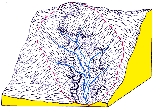Preamble
Successful watershed development (WD) projects have demonstrated the capacity to regenerate entire communities, socially and economically. During the World Bank project executed by Sankalpa Trust, it was shown that watershed development is a crucial component of biomass growth strategies, which leads to ecofriendly technogies for the generation of electrical power for the masses in the rural areas. WD Projects are therefore high on the priority of ARTS for generating sustainable livelihoods.

A watershed (or catchment) is a geographic area that drains to a common point, which makes it an attractive planning unit for technical efforts to conserve soil and maximize the utilization of surface and subsurface water for crop production.
Excess surface runoff water is harvested in irrigation or percolation tanks while subsurface drainage recharges groundwater aquifers, so conservation measures in the upper watershed have a positive impact on productivity in the lower watershed. Reducing erosion in the upper reaches of the watershed also helps to reduce sedimentation of irrigation tanks in the lower reaches. The watershed approach enables planners to internalize such externalities and other linkages among agricultural and related activities by accounting for all types of land uses in all locations and seasons. This systems-based approach is what distinguishes watershed management from earlier plot-based approaches to soil and water management.